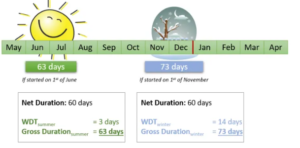Planning and weather; and introduction
The project manager, overseeing the development of the project schedule, to a certain degree will always be victim to the planning fallacy and underestimate the risks involved in execution. Some of those risks are related to weather and this article will set the stage for discussing some useful methods for dealing with weather when developing a schedule.
Note that actual methods for incorporating weather risks into the planning are addressed in the blogpost “Planning and Weather – Acceptable methods” (to be published soon).
What is adverse weather?
First of all, we are not talking about ‘bad weather’. That is too loosely defined and subjective. In planning, we use the term ‘adverse weather’, where adverse means ‘having a negative or harmful effect on something’. Activities can be hindered by wind, precipitation, frost and humidity and sequentially mud, ice or reduced visibility. But some activities like painting or concrete works can also be adversely influenced by heat or draught. The negative effect could be a production rate which is lower than planned: precise outdoor crane work will take significantly longer on a windy day compared to the same hoisting job executed indoors. But those same crane works can also become impossible if strong gusts of wind follow each other up too frequently. In that case we talk about postponed and suspended activities.

Figure 1: Dust storm in Western Australia during the 2012-2013 cyclone season, messing up the planning of multiple on- and offshore projects
Closely related to this is “sea state”. Offshore construction projects suffer not only from weather, but also from waves, swell and current, together known as sea state. Marine equipment will have specific threshold values, depending on the equipment and activities to be executed, above which work will be suspended.
Contract
Many contracts in the construction industry will include clauses regulating the settlement of weather impact. In a lumpsum contract, a certain amount of non-work days can be included in the contract price – e.g. the impact of weather conditions with a probability of occurrence of 50%. If the contractor experiences more delays than foreseen (and objective weather data supports this), he is usually entitled to an extension of time, but no money. These are excusable, non-compensable events to speak in terms of our change control and forensic schedule analysis trainings. Those additional delays are caused by what we call “excessive weather”: weather conditions in excess of what was foreseen in the contract.
To make it more concrete, let’s have a look at table 1. The contract can for example include information on the ‘expected’ workability, here shown as the expected number of non-work days. Those are valid for specific equipment, locations and activities only, however for simpler projects they might apply for all the works and for the whole site. In the latter case, this means that in December, the project is expected to have no progress for 7 days and those days are included in the price or paid for. Any non-working days in excess of 7 for December are usually not reimbursable, but an extension of time for completing the works might be granted (potentially only after correcting for the differences during the other months).
Table 1: Example of non-work days per month
Planning
Not to confuse yourself, you should always know your durations. Make the distinction between net duration, contingency (to cover risks), weather downtime (WDT) and gross duration. Let’s immediately discuss an example.
Assume a weather sensitive activity which – in perfect conditions – is expected to take 60 days to be executed. Net duration thus equals 60 days. Assume no provision for risks other than weather. How should you now calculate the gross duration? Have a look at table 1: it clearly depends on when you plan to execute the activity. When you plan a start date on the 1st of June, you only need to account for 3 days of WDT (2 days in June, 1 day in July and WDT in August is negligible). See also Figure 2.
Now, imagine that the start of the activity is delayed to 1st of November due to fabrication issues. The net duration is obviously still 60 days. But what WDT should we now take into account? Well, the sum of expected WDT in November (5 days), December (7 days) and a bit in January. At the 31st of December, we expect to have on average 11 days of net duration which still has to be executed. Assuming even distribution of the 6 days WDT in January, we can attribute approximately one third of this to the activity, or 2 days. In Figure 2 you can see this summarized.

Figure 2: WDT in summer and winter
This example proves the importance of the use of a proper method for planning weather impact: Delaying an activity can have a large impact on its gross duration. Several methods – see our future blogpost Planning and Weather – Acceptable methods – are available and they all have their merits in specific situations.
Conclusion
When planning weather sensitive activities, don’t forget to take the possible impact of adverse weather into account. It starts with finding and analysing historical weather data and implement them in a sound way in your schedule. To be able to do this, you have to be familiar with the equipment to be used and their limits. Also, the contractual determinations and implications of weather-related delays should be fully understood for proper administration of these events. Do not hesitate to involve professionals to guide the way: being in control of this essential part of your planning will prove to be very rewarding.



